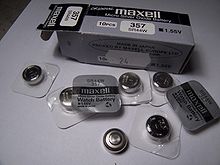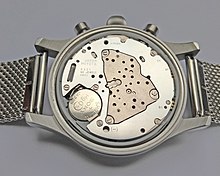Silver oxide battery
This article needs additional citations for verification. (May 2008) |
 Silver oxide cells | |
| Specific energy | 130 Wh/kg[1] |
|---|---|
| Energy density | 500 Wh/L[1] |
| Specific power | High |
| Charge/discharge efficiency | N/A |
| Energy/consumer-price | Low |
| Time durability | High |
| Cycle durability | N/A |
| Nominal cell voltage | 1.55V |

A silver oxide battery (IEC code: S) is a primary cell using silver oxide as the cathode material and zinc for the anode. These cells maintain a nearly constant nominal voltage during discharge until fully depleted.[2] They are available in small sizes as button cells, where the amount of silver used is minimal and not a prohibitively expensive contributor to the overall product cost.
Silver oxide primary batteries account for 30% of all primary battery sales in Japan (64 out of 212 million in February 2020).[3]
Large silver oxide batteries were used on early ICBM's and satellites because of their high energy-to-weight ratio. For example the Corona reconnaissance satellites used them, as did the Agena-D rocket upper stage.[4] Later, they were also used in the Apollo Lunar Module and lunar rover.[5][6]
Chemistry
[edit]A silver oxide battery uses silver(I) oxide as the positive electrode (cathode), zinc as the negative electrode (anode), plus an alkaline electrolyte, usually sodium hydroxide (NaOH) or potassium hydroxide (KOH). The silver is reduced at the cathode from Ag(I) to Ag, and the zinc is oxidized from Zn to Zn(II).
The half-cell reaction at the positive plate:
- ,
The half-cell reaction at the negative plate:
- ,
Overall reaction:
- ,
Overall reaction (anhydrous form):
Mercury content
[edit]
Until 2004, all silver oxide batteries contained up to 0.2% mercury, incorporated into the zinc anode to inhibit corrosion from the alkaline environment.[7] This corrosion would occur regardless of whether or not the battery was providing power, making shelf life an important consideration with silver oxide batteries. Sony started producing the first mercury-free silver oxide batteries in 2004.
See also
[edit]- Battery nomenclature
- Battery recycling
- Comparison of battery types
- Fuel cell
- History of the battery
- List of battery sizes
- List of battery types
References
[edit]- ^ a b "ProCell Silver Oxide battery chemistry". Duracell. Archived from the original on 2009-12-20. Retrieved 2009-04-21.
- ^ "Silver Oxide Batteries". muRata. Retrieved 25 November 2020.
- ^ "Monthly Battery Sales Statistics". Baj.or.jp. MoETI. May 2020. Archived from the original on 2010-12-06. Retrieved 2020-08-07.
- ^ "Feasibility Study, Final Report, Geodetic Orbital Photographic Satellite System, Volume 2" (PDF). NRO. June 1966. Archived from the original (PDF) on 2012-03-16. Retrieved 2011-01-28.
- ^ Clemens, Kevin (2019-07-05). "The Batteries That Powered the Lunar Module". designnews.com. Retrieved 2021-02-02.
- ^ Lyons, Pete; "10 Best Ahead-of-Their-Time Machines", Car and Driver, Jan. 1988, p.78
- ^ World’s First Environmentally Friendly Mercury Free Silver Oxide Battery. September 29, 2004.
External links
[edit]- SR (Silver Oxide Battery) from Maxell







![{\displaystyle {\ce {Zn + Ag2O ->[{\ce {KOH/NaOH}}] ZnO + 2Ag (v)}}}](https://wikimedia.org/api/rest_v1/media/math/render/svg/9d624e40c1465ee6f8cef5029af69fec52b25ccd)
